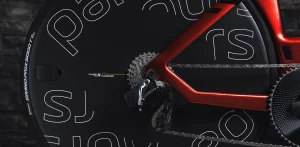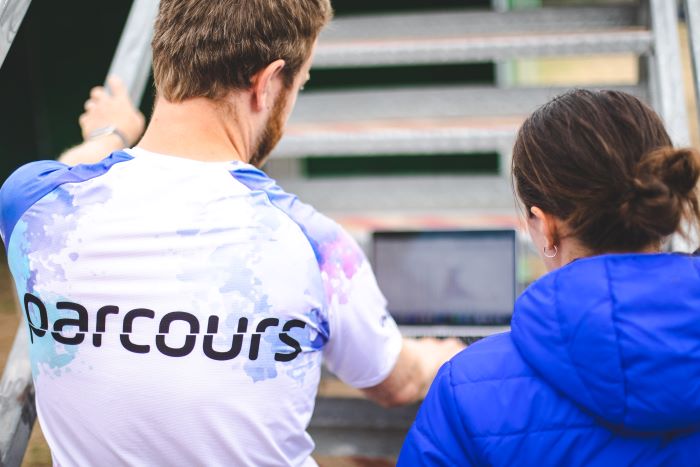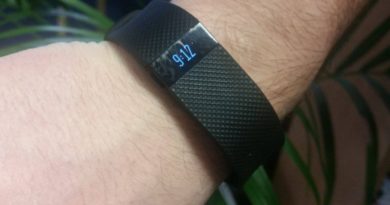Parcours Velo: A British export success story
When CI.N bumped into Dov Tate from Parcours at The Cycle Show an interesting conversation about international business unfolded. Whilst UK riders, retailers, and distributors will know Parcours as a D2C business, fewer will be aware of the international success of the business. This really caught our attention; a British business with substantial overseas success! Here we find out more about how Parcours services international markets via its own distribution and retailer network.
First up, lets go straight at the challenge facing many: Overstock.
Yeah, it’s interesting – overstock is one challenge we haven’t run into. I think part of that is our supply chain being incredibly efficient. So we haven’t had to front load in the way that other brands might have had to. We can be a bit more reactive to demand, versus having to, you know, look on a six, nine-month horizon.
What was helpful for us, and I think there’s as much judgement as there is luck in this, was that the overall slowdown began to coincide with the northern hemisphere winter, which is naturally a quieter time for us anyway.
We’ve actually been out of stock of a fair few of our most popular models, which nicely demonstrates that overstock actually hasn’t been a problem for us. Given the nature of the way we work with overseas partners we’ve had the flexibility. It means that if we need to adjust demand geographically, we can divert stock, at source, from the factory. Just this morning I was talking to a distributor who needs to up their current order. We’ll probably be able to fulfil that at short notice by tweaking down on somebody else who wanted to reduce. By doing that from sort of one central manufacturing facility means we can sort of feel different buckets if that makes sense.
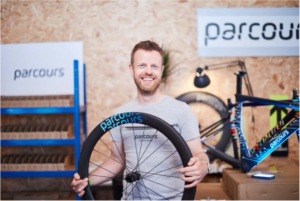
For managing the stock and demand levels, the flexibility and adaptability of our supply chain has been massively useful. Equally, this helps us do things like gold wheels that we saw at The Cycle Show. We were able to execute that pretty quickly simply because we have such an efficient supply chain which we’re able to rely upon. That’s been really helpful for sure.
Geographically, there’s a variety of different trends on display across international markets, and that goes beyond seasonality. In some parts of Asia, the seasons don’t quite apply in the same way because you’re going from dry to rainy rather than from hot to cold. Then throw in the southern hemisphere, then that flips it on its head. We’re just coming out of summer and going into winter down in Australia. Speaking to the guys in Australia, the focus there shifts toward Ironman Cairns.
Here we can see that geographic diversification helps mitigate some of the impacts that you’re seeing. If we were purely UK focused, we’d have been coming out of an incredibly challenging period, affected by cost of living, concerns about the economy, a terrible winter, and probably some level of overstocking. For Parcours, by having diversified in the way we have, over the past two or three years, it’s massively diluted any impact on us. That’s not to say it’s been easy, but it just means that we’ve had more options, taking from one side, fill another, just to make things happen. That’s only been possible by being incredibly flexible and incredibly reactive.
When we chatted at The Cycle Show you mentioned doing business in India and a number of Southeast Asia based markets. Distribution wise, how are you set up now? How many distributors and how many countries?
Our Asian distribution network spans India, South Korea, Indonesia, Malaysia and Singapore, naturally varying in size for each market. For example, in Indonesia – naturally a smaller market – the performance sector is more concentrated, with fewer suppliers.
In comparison, India is very much a traditional, retailer-based, market. The challenge there is finding a distributor who can reach out to a retailer in the north of the country, the middle of the country and the south of the country. Cultural differences are significant, and really matter. You’ve got different languages, you’ve got different cultures, you’ve got different climates, you’ve got different road conditions – it’s incredibly diverse. Here you rely upon your distributor, who is responsible for those relationships, whilst the retailer makes sales.
In each of these 5 countries we have distributor relationships, but each distributor must be tailored to the market. We’re still learning the nuances of different markets. Equally so, the rider types are very different. Different models sell better in different countries. Sometimes that’s all trend based, and fashion based.
In China, and South Korea, performance rim brake bikes and wheelsets are still really strong. Partly, I suppose, because of weather conditions. In a European / North American marketplace we just don’t see that.
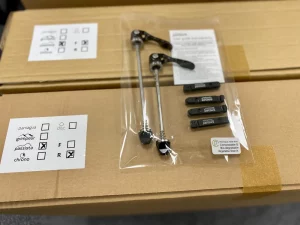 Yeah, it’s interesting. Giving a broad, generalised, overview, we see similarities in the South Korean and Japanese markets, where riders are very focused on weight. That obviously lends itself to the rim brake setup.
Yeah, it’s interesting. Giving a broad, generalised, overview, we see similarities in the South Korean and Japanese markets, where riders are very focused on weight. That obviously lends itself to the rim brake setup.
In comparison, a substantial number of riders in India are very focused on aerodynamics. Naturally enough, this isn’t the case for the entire market, however, we do see a love for a deep wheel. You know, we actually put a lot of deep wheels onto Road bikes there. Whereas, in comparison, I would say that a significant section of Malaysian cyclists are very much more tech focused, very brought into wider tyres, disc brakes, lower tyre pressures, aero performance.
Here you can see the importance of good local partnerships, working with local contacts and businesses. They know the market. As much as we can sit there and say to them, ‘you know, based on our online sales, this is the product mix we see….’, their product wants, and the sales they make, are often quite different.
Amy Marks now runs global marketing, setting up and delivering global branding and messaging. Here we still leave it to the country-based distributors to localise the messaging, understanding that they use elements which relate best to their customers. They can always come back to us for support and further detail where needed. The takeaway for me is that we shouldn’t be, can’t be, dictating what people should be thinking in the way that a brand might want to. It’s more understanding what the market is looking for as much as what we think they should have.
Is British product still seen as a strong selling point in these markets?
There is a certain gravitas, I think, given to a European brand. I think that we carry a lot of weight on the basis that Parcours is a British brand. Yes, we’re completely transparent about the fact we don’t do the manufacturing or assembly in the UK, rather doing the design and development in the UK.
I think in terms of quality. People in those markets understand that we’re not going to settle for sub-par quality. There is a certain element of quality that we are going to demand of our suppliers, and that gives international customers the comfort to go ahead and make a purchase.
Origin certainly can create expectation. Prime example: The difference between the UK and US view of German engineering. In the US (we’re talking automotive industry here), they’ll laugh at German engineering – often seen as overly complex, and not reliable. In the UK, we get a totally opposite German engineering message. Same product. Two totally different market perceptions.
It’s definitely an interesting one. On a visit with a distributor, we were discussing who we see as our competitors, and how they should position our brand and product when they’re speaking to retailers.
Our brand message is that we are, performance wise, on a par with top international brands. Our point of difference is the price point. Importantly, rather than saying we’re competing on price, we’re focused on amplifying our performance credentials, setting expectations.
Do you see brands like Light Bicycle, Winspace, Farsports, and Yoeleo as competitors in Asian markets?
We don’t see ourselves as competing against direct-to-consumer Chinese owned brands. Interestingly, they’re not a factor because the consumers in many overseas markets we’re active in just weren’t considering buying a Chinese brand. Even though you and I know that the quality of product is really good – Winspace make a very good wheel.
 The point of difference that I would always come back to, from our side, is the R&D that goes into our products. From a construction and a build quality perspective you often can’t knock the Chinese brands. But I think that the brand perception, being European, plays substantially in that part of the world.
The point of difference that I would always come back to, from our side, is the R&D that goes into our products. From a construction and a build quality perspective you often can’t knock the Chinese brands. But I think that the brand perception, being European, plays substantially in that part of the world.
Strong Parcours sales are built on R&D investment. It’s been really, really, successful for us. We’ve got good relationships there now, and I think that the brand is establishing itself nicely in those markets, which is really pleasing.
You mentioned a hybrid model for distribution in Australia where you have a retailer / distributor?
Yeah, we went with a retailer in Melbourne; Just Pedal. I think that works really nicely because you know firstly it gives us that local presence in terms of after sales support, if needed. It gives people the confidence because at the end of the day, if people do have a problem in Australia, if they did need to return a wheel to us, then you know, best case scenario that’s a two to three-week turn around without any shipping delays. Whereas if it’s somebody in market, then it’s just a much more straight forward process.
From their perspective, Just Pedal can obviously tap into their existing customer base. They can then tap into a wider customer base within their geographical footprint. In terms of leveraging our presence in the market, we can also point people towards Just Pedal.
The step after that is then saying, ‘right, how do we then build the relationships beyond just our existing customer base?’ That includes putting products into other retailers, or into other partners, whatever they may look like. Also fulfilling orders locally.
So, on a very basic level, you can say that the sales margin is blended across a direct customer, an online customer, and also a B2B customer. They’re basically fulfilling that from one stockpile.
This gives Just Pedal multiple routes to market, whilst also minimising the number of points of contact we have to have, and also making sure that we can deliver whatever after sale services needed in a timely and high-quality manner.
Growth, at what cost?
Ultimately the biggest constraint that we’re always going to face as a growing business is cash flow.
You know every pound, dollar or euro that we put into stock that sits overseas is a pound, dollar or euro that’s not sitting on the shelves in the warehouse here. It’s a risk when we know that we are already selling more than we can get hold of at the moment in the UK.
It’s just trying to figure out a capital effective way of reaching these markets without having to overcommit. We’ve no interest in compromising what we’re doing.
